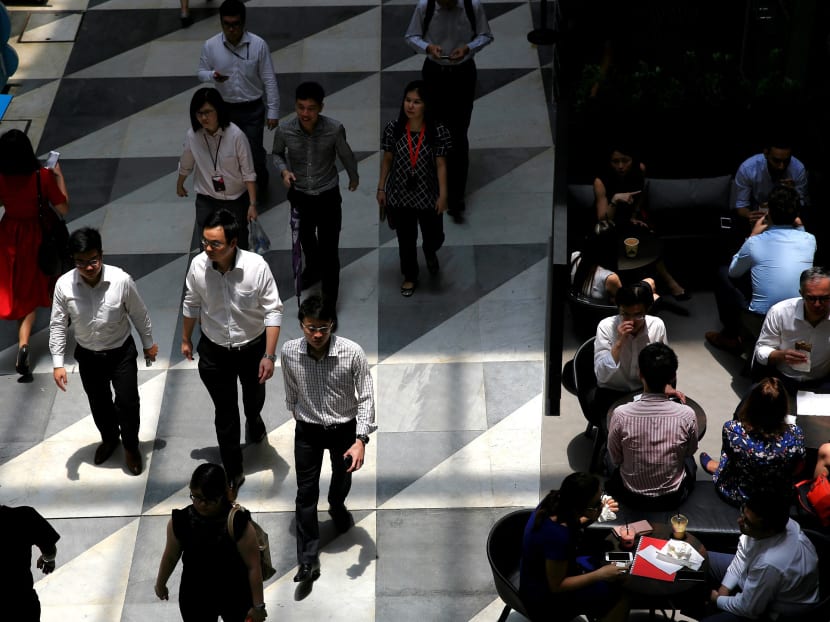Overall unemployment rate creeps up: MOM report
SINGAPORE — While layoffs dipped in the first quarter of this year, the overall unemployment rate continued to edge up, preliminary estimates released on Friday (April 28) by the Ministry of Manpower (MOM) showed.
SINGAPORE — While layoffs dipped in the first quarter of this year, the overall unemployment rate continued to edge up, preliminary estimates released on Friday (April 28) by the Ministry of Manpower (MOM) showed.
Pointing to a “mixed” picture, the MOM report also showed that the total number of people in employment shrank.
Seasonally adjusted, the overall unemployment rate — which covers citizens and permanent residents as well as foreigners living in households here — crept up from 2.2 per cent to 2.3 per cent between the end of the fourth quarter of 2016 and the first quarter.
The unemployment rate for citizens and permanent residents, however, stayed unchanged over the same period (3.2 per cent), as did the citizen unemployment rate (3.5 per cent). An estimated 74,400 residents were estimated to be jobless at the end of the first quarter.
Meanwhile, the number of layoffs dipped slightly from 5,440 to 4,800 between the fourth quarter of 2016 and the first quarter, with redundancies continuing its climb in the construction and services sectors.
The services sector accounted for more than six in 10 redundancies (63 per cent). For the whole of last year, the number of job redundancies stood at 19,170, the highest since the 2009 global financial crisis.
Total employment, meanwhile, contracted by 8,500, after it grew by 2,300 in the fourth quarter of last year, owing mainly to a dip in the number of work-permit holders in the construction and manufacturing sectors.
For instance, the number of people employed in construction dipped by 12,900, the third straight quarterly fall.
‘GLOBAL PICK-UP MAY PASS US BY’
The Monetary Authority of Singapore, in its biannual Macroeconomic Review on Thursday, had said global economic conditions were set to pick up in the coming months, led by the United States and Japan.
Singapore’s economy is still expected to grow 1 to 3 per cent this year, with some economists expecting the forecast to be revised to the upper end of the spectrum in the months ahead.
Economists who spoke to TODAY said that an improvement in the labour market would depend not only on the quality of economic growth, but also the extent to which economic restructuring efforts bear fruit.
CIMB Private Banking economist Song Seng Wun said a labour market pick-up would hinge on the extent of economic growth, which could be concentrated only in certain sectors, such as chemicals and precision engineering.
It would take a “broad-based recovery”, where growth spills over into other sectors, for businesses to start hiring again, and he expects this to happen from the second half of the year.
He noted that structural issues may still remain, since workers with specialised skills who were laid off from sectors such as offshore and marine were still struggling to land jobs elsewhere.
Mr Vishnu Varathan, head of economics and strategy at Mizuho Bank, said growth has still not reached a momentum that would create jobs at “sufficient pace”. Economic growth of between 1 and 3 per cent was still “sub-par” and inadequate to “reverse the course into a … recovery” in the labour market, he added.
While the Republic was in the “initial phases” of growth, employers would gain confidence to hire at a greater pace when they see orders picking up more significantly.
DBS Bank senior economist Irvin Seah said the labour market has been dogged by structural factors. As the economy restructures and workers – particularly older ones – struggle to adjust to this “new normal” and pick up new skills, any improvement will be “very gradual (and) marginal”, he said.
Agreeing, labour economist Walter Theseira from the Singapore University of Social Sciences said an improvement would be contingent on the success of the Republic’s restructuring efforts. “Global economic growth may well pass us by if our economy’s not competitive and we don’t pick up any effects from the increase in demand – (for example), if our factories and workers aren’t productive enough,” he said.









